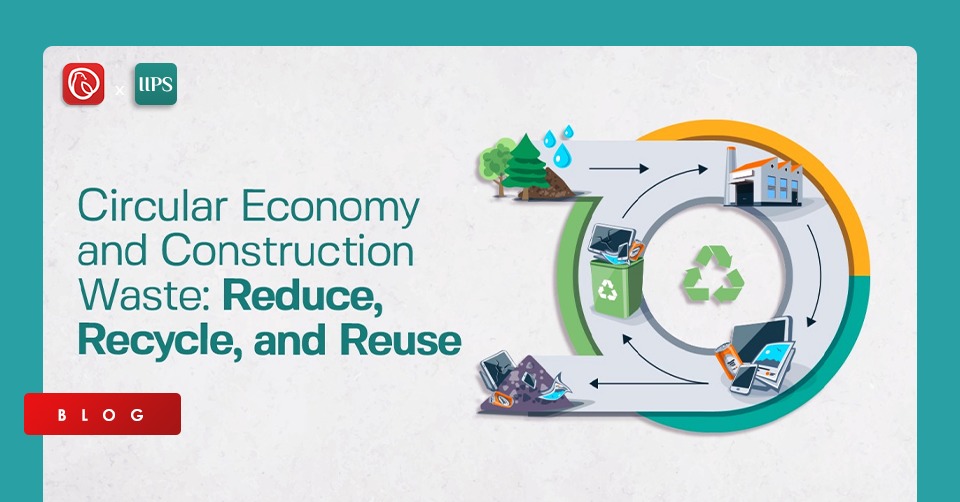Introduction
In a world that is constantly being driven by increased consumption of materials and extraction of earth’s natural resources, conscious efforts must be made towards reducing waste, recycling materials, and re-using items to ease the strain on planetary resources. The “take-make-dispose” approach to production and consumption is being challenged all over the world today. In 2019, more than 92 billion tonnes of materials were extracted from the earth and processed for consumption, accounting for nearly half of the global CO2 emissions. The resulting waste included plastics, textiles, electronics and other harmful materials that are also taking a further toll on the environment and human health. Moreover, more than 30 per cent of the total solid waste generated in the world consists of construction and demolition waste. The concept of a circular economy promotes the elimination of waste. It encourages the safe use of the earth’s natural resources, offering up to USD 4.5 trillion in economic benefits to the world. This swift research article by the Iqbal Institute of Policy Studies will dilate on circular economy and construction waste in Pakistan.
What is a Circular Economy?
With increasing urbanisation and population growth, it has become more critical to create a more sustainable future that allows the natural environment to recover its resources and protect itself from the negative effects of industrialised waste. Urbanisation grew from 14% to 54% between 1900 and 2015 and will reach 66% by 2050. Also, resource extraction increased by 12-fold during the same period. Realising the harmful side-effects of unregulated consumption with minimal recycling and reuse, circular economies were conceptualised in the 1970s to promote a society where nothing goes to waste. It has become a vision for progressive leaders and campaigners all over the world. It refers to an economic system that replaces the ‘end-of-life’ concept with reducing, reusing, recycling, and recovering materials in production, distribution, and consumption processes. The goal is to achieve sustainable development to promote environmental equity, economic prosperity, and social equity (Kirchherr, 2017).
As input commodities were inexpensive and widely available, the linear model of economies was developed but is no longer sustainable, thus requiring a new, more sustainable model. Circularity challenges this approach with valuable materials applications, an extension of product lifetimes, and smarter product use and manufacture. It is possible to visualise the circular economy concept in two dimensions, before and after use. The idea of upstream circularity (before use) involves managing resources efficiently, improving production and consumption productivity, minimising waste, and keeping production costs as low as possible. Circularity downstream (after use) is about maximising the value of waste materials. Value preservation, resource optimisation, and system effectiveness are three characteristics of an effective circular economy. Cities are ideal for implementing circular economies since they generate over 80 per cent of the global GDP.
How can Construction and Demolition Waste be Used in a Circular Economy?
The construction industry has horizontal and vertical linkages with more than 40 allied sectors of the economy and is a significant contributor to the overall growth. Not only does it have an economic impact, but it also touches the lives of millions of people as their quality of life depends on the built environment surrounding them. However, the construction industry’s appetite for raw materials is vast. About 30 per cent of the solid waste generated in Pakistan comes from the construction industry. There is an excellent opportunity to create closed material loops towards establishing a circular economy. Construction and demolition waste is surplus constituents generated from the construction, renovation, and demolition of infrastructure. However, the quality and quantity of construction waste generated from any specific activity vary depending on multiple factors. Poor handling of materials, inadequate storage and protection, over the ordering of materials, poor site control, lack of training, poor stock control, and damage to materials during delivery are significant causes of construction waste generation.
Construction waste can be categorised into three main categories, namely, inert, non-inert, and hazardous. The first category includes soil, sand, rocks, concrete, aggregates, plaster, bricks, masonry blocks, glass, and tiles. The second category includes wood, paper, drywall, gypsum, metals, plastic, cardboard, and packaging, whereas the last category includes flammable materials like paints and corrosive materials like acids, bases, and explosives (Park, Kim, Roh, & Ban, 2020). A study conducted on 30 construction sites revealed that concrete (12.32%), metal (9.62%), brick (6.54%), plastic (0.43%), wood (69.10%) and others (2%) are some of the major categories of waste generated during construction. Considering global standards, construction waste accounts for a substantial share of 25 to 30 per cent of the total solid waste generated worldwide. It takes 10 to 30 per cent of all waste in landfill sites. According to studies conducted in countries around the globe, construction waste in Pakistan is around 20 to 30 per cent of the total solid waste generated in the country. Approximately 10 to 30 per cent of all waste in landfill sites can be categorised as construction waste.
The Prospects for a Circular Economy
The concept of a circular economy revolves around the reduce, recycle and reuse strategy. It is also famously known as the 3R principle. Very little gets reused or recycled in the construction industry, and most construction waste is generated because of inefficient use and over the ordering of materials. Therefore, construction will have a significant impact on the way the world uses its natural resources in the future. Even though these materials could be used in several cases, less than a third of all construction waste is recovered and reused (Breene, 2016). Not only does this involve a significant waste of natural resources, but it also leads to the loss of valuable minerals, metals, and organic materials. A circular economy can become a viable alternative by promoting products that are “made to be made again” while also powering the system with renewable energy. Applying this principle to the construction industry can bring about many cost benefits. With the help of the government and regulators, small changes in material management and construction process optimisation can lead to energy savings of more than 30 per cent. Therefore, efforts should be made towards optimising the recycling and reuse of construction waste while also reducing consumption.
Conclusion
The construction industry is one of the most resource-intensive and demanding sectors of the economy. The industry is also a significant cause of solid waste generation. However, most of this waste is not recycled or reused, whereas 30 per cent of it can be repurposed for different cases. The concept of a circular economy focuses on designing products and strategies that encourage the reuse of materials and products, reducing the levels of waste generated in society. Therefore, it is high time that the construction industry adopts the circular economic model and reduces, recycles, and reuses the waste generated.




